| |
|
Xiamen Oil Paintings, Wholesale Direct!
|
|
100% hand painted, 100% cotton canvas, 100% money back if not satisfaction. |
|
|
|
|
ART WORKS INDEX
A
B
C
D
E
F
G
H
I
J
K
L
M
N
O
P
Q
R
S
T
U
V
W
X
Y
Z
|
|
ARTISTS INDEX
A
B
C
D
E
F
G
H
I
J
K
L
M
N
O
P
Q
R
S
T
U
V
W
X
Y
Z
|
|
|
|
 |
Eric Ravilious
|
|
British Painter, ca.1903-1942
English painter, wood-engraver and designer. He was educated at Eastbourne School of Art and then at the Royal College of Art (1922-5), where he was taught by Paul Nash and became close friends with Edward Bawden. His early works included the refectory mural (destr. 1940) in Morley College, London, and wood-engravings in the tradition of Bewick for the Golden Cockerel, Curwen and Nonesuch presses. In the 1930s he began painting larger compositions in a wider range of colour, and this led him to use lithography for such illustrations as those for High Street. Ravilious also produced designs for Wedgwood, including the celebration mug (1936) for the coronation of King Edward VIII, which was withdrawn and revised for the coronations of George VI and Elizabeth II; the Alphabet mug (1937); the Afternoon Tea (1937), Travel (1938) and Garden Implements (1939) china sets; and the Boat Race Day cup (1938). He also designed glass for Stuart Crystal (1934), furniture for Dunbar Hay (1936) and graphic work for advertisements for London Transport and others. Despite his success as a designer, Ravilious concentrated increasingly on watercolours. His landscapes and rural interiors often featured the downland and coast of southern England; haunting and lyrical, these works show a world in suspense and often feature chalk hill figures, as in Train Landscape (c. 1939; Aberdeen, A.G.) and empty rooms.
|
|
|
|
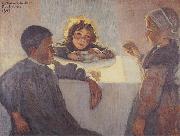 |
Eric Forbes-Robertson
|
|
(1865-1935).
a figure and landscape painter
a figure and landscape painter.was a Scottish painter of landscapes, flowers, and foliage, with children. He was a cousin of James Hornell. He was born in Australia, of Scottish parents, and he was brought up and lived practically all his life in Scotland, at Kirkcudbright. He studied for three years at the art school at Edinburgh, and for two years at Antwerp under Professor Verlat. Returning from Antwerp in 1885, he met George Henry and associated himself with the Glasgow School. Hornel and Henry collaborated upon "The Druids Bringing In The Mistletoe" (1890), a procession of priests bringing in the sacred mistletoe, gorgeous with polychrome and gold. The two worked side by side to achieve decorative splendor of color, Hornel boldly and freely employing texture effects produced by loading and scraping, roughening, smoothing, and staining. In 1893-94 the two artists spent a year and a half in Japan, where Hornel learned much about decorative design and spacing. Towards the close of the nineties his colors, while preserving their glow and richness, became more refined and more atmospheric, and his drawing more naturalistic, combining sensuous appeal with emotional and poetic significance. In 1901 he declined election to the Royal Scottish Academy. In 1901 he acquired Broughton House, a townhouse and garden in Kirkcudbright, which was his main residence for the rest of his life.
|
|
|
|
 |
Ercole Roberti
|
|
1456-1496
Italian
Ercole Roberti Gallery
Ercole de' Roberti (c. 1451 ?C 1496), also known as Ercole Ferrarese or Ercole da Ferrara, was an Italian artist of the Early Renaissance and the School of Ferrara. He was profiled in Vasari's Le Vite delle pi?? eccellenti pittori, scultori, ed architettori.
The son of the doorkeeper at the Este castle, Ercole later held the position of court artist for the Este family in Ferrara. According to Vasari:
By 1473, when he was 17, Ercole had left Ferrara and was working in Bologna in the studio of Francesco del Cossa. (According to Vasari, Ercole also apprenticed under Lorenzo Costa in Bologna, but this seems unlikely as he was Lorenzo's senior by seveal years). He is known to have collaborated in the frescoes of Palazzo Schifanoia.
Ercole's first mature works are his contributions to the Griffoni Chapel for the San Petronio Basilica in Bologna: a predella depicting the Miracles of St Vincent Ferrer (c.1473) (now in the Pinacoteca of the Vatican), and lateral pilasters for the altarpiece commissioned from del Cossa.
In 1480, Ercole created a large altarpiece with a Madonna and Child Enthroned with Saints for Santa Maria in Porto in Ravenna, which is now in the Brera, Milan. Portraits of Giovanni II Bentivoglio and Ginevra Bentivoglio attributed to Ercole de' Roberti (c. 1480) are in the National Gallery of Art, Washington, D.C.
Ercole succeeded Cosm?? Tura as court painter to the Este family in Ferrara around 1486. His role apparently went far beyond making art: he accompanied Alfonso d'Este on a papal visit to Rome, served as wardrobe manager for Isabella d'Este's wedding in Mantua, and may even have made salamis.
A painting of Portia and Brutus (c. 1486-90), believed to be painted for Eleonora of Aragon, duchess of Ferrara, is in the Kimbell Art Museum, Fort Worth, Texas. Ercole's painting of Saint Jerome in the Wilderness from this period is in the collection of the J. Paul Getty Museum, Los Angeles.
|
|
 |
Ercole de Roberti
|
|
Ferrara ca 1451/56-1496
was an Italian artist of the Early Renaissance and the School of Ferrara. He was profiled in Vasari's Le Vite delle pi?? eccellenti pittori, scultori, ed architettori. The son of the doorkeeper at the Este castle, Ercole later held the position of court artist for the Este family in Ferrara. According to Vasari: Ercole had an extraordinary love of wine, and his frequent drunkenness did much to shorten his life, which he had enjoyed without any accident up to the age of forty, when he was smitten one day by apoplexy, which made an end of him in a short time. Paintings by Ercole are rare.
|
|
 |
Erastus Salisbury Field
|
|
1805-1900
American painter. He studied with Samuel F. B. Morse in New York during the winter of 1824-5. On his return to the rural isolation of Leverett, MA, he painted his earliest known work, the portrait of his grandmother Elizabeth Billings Ashley (Springfield, MA, Mus. F.A.). His career as an itinerant portrait painter began in 1826, most of his commissions coming through a network of family associations in western Massachusetts and Connecticut. The portraits of 1836-40 are considered his best. From 1841 he lived mainly in New York, where he expanded his subject-matter to include landscapes and American history pictures. There he presumably studied photography, for on his return to Massachusetts he advertised himself as a daguerreotypist. His few portraits painted after 1841 are copied from his own photographs and lack the expressive characterization and decorative power of his earlier work. From 1865 to 1885 his paintings were based primarily on biblical and patriotic themes. The Historical Monument of the American Republic (1867-88; Springfield, MA, Mus. F.A.) stands alone in American folk art in size (2.82*3.89 m), scope and imaginative vision. Inspired by plans for a national celebration of the centennial of the USA in 1876, Field painted an architectural fantasy of eight towers linked by railway bridges and trains at the tops, with the history of the USA in low-relief sculpture on the exterior surfaces of the towers. Field added two more towers to the painting in 1888 and thereafter retired.
|
|
|
|
|
|
 |
Eouard Manet
|
|
He was a French painter. One of the first 19th-century artists to approach modern and postmodern-life subjects, he was a pivotal figure in the transition from Realism to Impressionism.
His early masterworks, The Luncheon on the Grass (Le dejeuner sur l'herbe) and Olympia, engendered great controversy and served as rallying points for the young painters who would create Impressionism. Today, these are considered watershed paintings that mark the genesis of modern art.
|
|
 |
Enoch Wood Perry, Jr.
|
|
(1831-1915) was a painter from the United States.
Perry was born in Boston on July 31, 1831. His father was Enoch Wood Perry, and mother was Hannah Knapp Dole. His maternal grandparents were Samuel Dole and Katherine Wigglesworth. The family moved to New Orleans with his family as a teenager in 1848 and attended its public schools. After working several years as a clerk in a commission house, Perry began formal art education. In 1852 he went to Europe for four years and studied with Emanuel Leutze at the Desseldorf Academy, Thomas Couture in Paris, and in Rome.Perry served as the U.S. Consul to Venice between 1856 and 1858. Upon returning to America, he opened a studio in Philadelphia.
|
|
 |
Enoch Seeman
|
|
Enoch Seeman the Younger was born in Danzig, now Gdansk, Poland, around 1694. His father, also Enoch was born around 1661, and the Seeman family were painters.
Having been brought to London from his home of Flanders by his father in 1704, the younger Seeman's painting career as we know it began with a group portrait of the Bisset family in the style of the portraitist Godfrey Kneller, now held at Castle Forbes in Grampian, Scotland, and dated by an inscription 1708.
As a painter to the British royal court Seeman the Younger completed portraits of George I, in 1730, in the robes of his coronation and of George II some years later. The first of these pictures is held at the Middle Temple in London, England, and the second is at Windsor Castle in Berkshire, England, part of the royal collection.
In 1734, Seeman painted a portrait of Jane Pratt Taylor, daughter of Lord Chief Justice John Pratt. The portrait was sent to William Byrd, II of Westover, in Virginia, where it became part of the largest colonial portrait collection of the early eighteenth-century. The painting is now part of the collection of the Virginia Historical Society.
The Yale University Art Gallery owns a portrait of Elihu Yale in 1717 by Seeman and the Metropolitan Museum in New York, USA owns his rendering of Sir James Dashwood, described by the Grove Dictionary of Art as 'Exceptionally lively'. Also by Seeman the younger, Abraham Tucker in 1739 at the National Portrait Gallery in London, England, and various copies of sixteenth and seventeenth century portraits. The National Trust owns two examples of this set of his work - at Dunham Massey in Cheshire, England, a copy of a portrait of Lady Diana Cecil, and at Belton House in Lincolnshire, England, of Lady Cust and her Nine Children.
|
|
|
|
|
|
|
|
 |
EMPOLI
|
|
Italian painter, Florentine school (b. 1551, Firenze, d. 1640, Firenze)
|
|
|
|
 |
Emmanuel de Witte
|
|
Dutch
1617-1692
Emmanuel de Witte Gallery
Dutch painter. He was one of the last and, with Pieter Saenredam, one of the most accomplished 17th-century artists who specialized in representing church interiors. He trained with Evert van Aelst (1602-57) in Delft and in 1636 joined the Guild of St Luke at Alkmaar, but he was recorded in Rotterdam in the summers of 1639 and 1640. In October 1641 his daughter was baptized in Delft, where he entered the Guild of St Luke in June 1642 and lived for a decade, moving to Amsterdam c. 1652. He began his long career as an unpromising figure painter, as can be seen in the Vertumnus and Pomona (1644) and two small pendant portraits (1648; all Rotterdam, Mus. Boymans-van Beuningen).
|
|
 |
Emma Sandys
|
|
Emma Sandys (born Mary Ann Emma Sands) (1843 - 1877) was a 19th-century English painter.
Sandys was born in Norwich, England in 1843. She was taught by her father, Anthony Sands, and worked in portraits in both oil and chalk, often in medieval or period dress. Her earliest dated painting is marked 1863 and she exhibited her works in both London and Norwich between 1867 and 1874.
Sandys did most of her work around Norwich but may have spent time in the studio of her brother, Frederick Sandys, in London.
She died Norwich in November 1877.
|
|
|
|
|
|
|
|
 |
Emily Carr
|
|
Canadian Expressionist Painter, 1871-1945
Canadian painter and writer. She studied art from 1891 to 1894 at the California School of Design in San Francisco. She lived in England from 1899 to 1904, studying at the Westminster School of Art in 1899, and settled in Vancouver on her return. Her stay in Paris in 1910-11, during which she had a painting shown at the Salon d'Automne in 1911, proved far more influential on her art, familiarizing her with Impressionism, with Post-Impressionism and with Fauvism.
|
|
 |
Emilio Magistretti
|
|
(Milan, 1851 - 1936) was an Italian painter.
Magistretti studied at the Brera Academy of Fine Arts from 1871 to 1875 under the guidance of Francesco Hayez and then accompanied him on his Italian journey of 1879. He worked initially in a range of different areas, from genre scenes to religious subjects and perspective painting, and successfully tried his hand at painting portraits, animals and landscapes at the turn of the century. He began to establish his reputation as an artist in 1880, when he was awarded a prize by the Ministry of Education, and became well known as a painter of moderately naturalistic portraits particularly appreciated by the middle-class establishment. An autobiography richly illustrated with reproductions of his most celebrated works was published in 1926.
|
|
|
|
 |
emile-Rene Menard
|
|
(1861 - 1930) was a French painter born in Paris. From early childhood he was immersed in an artistic environment: Corot, Millet and the Barbizon painters frequented his family home, familiarizing him thus with both landscape and antique subjects.
Menard studied at the Academy Jullian from 1880 after having been a student of Baudry, Bouguereau, and Henri Lehmann. He participated in the Salon of the Secession in Munich, and the Salon de la Libre Esthetique in Brussels during 1897. Several personal exhibitions were also devoted to him at the Georges Small Gallery. In 1921 he exhibited in the Twelfth Salon along with Henri Martin and Edmond Aman-Jean. Galleries in Buffalo, New York and Boston, Massachusetts exposed Menard and his art to the United States. However, the numerous commissions that Menard received from the French government crowned his career; for example, the cycle for the Hautes Etudes e la Sorbonne, the Faculte de Droit, and the fresco Atoms for the Chemistry institute, and finally the Caise des Depôts in Marseilles.
Menard's art allies a rigorous, clear classicism with a diffuse and dreamlike brushwork. In 1894, Victor Shoe wrote of Menard in l' Art et la Vie (Art and Life): "visions of a pacified, bathed nature, of dawn and of twilight, where the soul seems to immerse itself in the innocence of daybreak, and breathe the divine anointment that comes with the dawn."
|
|
|
|
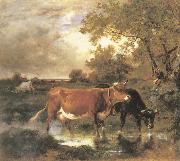 |
Emile Van Marcke de Lummen
|
|
1827-1890
Emile van Marcke was born in S??vres - into a family of artists. His father was Jean-Baptiste (1797-1848), the eldest son of Charles van Marcke and a painter who specialized not only in landscape and animal paintings, but also works on porcelain.
|
|
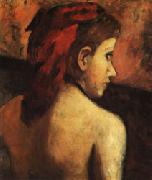 |
Emile Schuffenecker
|
|
French Post-Impressionist Painter, 1851-1934
French painter. In 1871 he entered the stockbroking firm of Bertin, where he met Paul Gauguin who was also employed there. In his spare time he took drawing classes and studied with Paul Baudry and Carolus-Duran, making his debut at the Salon in 1874. He also became acquainted with Armand Guillaumin and Camille Pissarro. Following the stock market crash of 1882, he, like Gauguin, was forced to leave Bertin and gained a job teaching art at the Lycee Michelet in Vanves. In 1884 he was one of the co-founders of the Salon des Independants and took part in the 8th and last Impressionist Exhibition in 1886, the year in which he also met Emile Bernard in Concarneau and sent him on to see Gauguin, thus initiating their joint development of CLOISONNISM. Though he mixed with the members of the Pont-Aven group his own artistic tastes were very different. While Gauguin and his disciples had little more than contempt for Neo-Impressionism, Schuffenecker was much interested in pointillist techniques.
|
|
|
|
 |
Emile Levy
|
|
Paris 1826 - Paris 1890.
French Academic Painter, 1826-1890.
Studied under François-Edward Picot and Abel de Pujol.
|
|
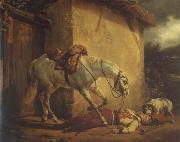 |
Emile Jean Horace Vernet
|
|
French, 1789-1863,Painter, son of Carle Vernet. He was born in his father's lodgings at the Palais du Louvre, where his grandfather Joseph Vernet also lived; his maternal grandfather was Jean-Michel Moreau. To these antecedents and influences are ascribed the supreme ease of his public career, his almost incredible facility and his fecundity. His early training in his father's studio was supplemented by formal academic training with Francois-Andre Vincent until 1810, when he competed unsuccessfully for the Prix de Rome. He first exhibited at the Salon in 1812. In 1814 Vernet received the Legion d'honneur for the part he played in the defence of Paris, which he commemorated in the Clichy Gate: The Defence of Paris, 30 March 1814.
|
|
 |
Emile Friant
|
|
French Realist Painter, 1863-1932, Was a French painter. With a naturalist style Emile Friant painted quotidian scenes involving people. His creations are characterized by the photographic realism of the human skin portions, and a less defined portrayal of the rest of the scene.
|
|
 |
Emile Claus
|
|
Belgian Painter, 1849-1924
Belgian painter. He had various menial jobs before the composer Peter Benoet persuaded his father to let him study at the Koninklijke Academie voor Schone Kunsten in Antwerp. He was taught there by Nicaise De Keyser and Jacob Jacobs (1812-79) but found the atmosphere uncongenial and soon left. In 1879 he travelled around Spain and North Africa and in 1881 went to live with his sister at Waereghem. His painting of this period was influenced by Charles Verlat and depicted rural subjects
|
|
 |
Emile Bernard
|
|
1868-1941
French
Emile Bernard Galleries
(b Lille, 28 April 1868; d Paris, 15 April 1941). French painter and writer. He was the son of a cloth merchant. Relations with his parents were never harmonious, and in 1884, against his fathers wishes, he enrolled as a student at the Atelier Cormon in Paris. There he became a close friend of Louis Anquetin and Toulouse-Lautrec. In suburban views of Asnires, where his parents lived, Bernard experimented with Impressionist and then Pointillist colour theory, in direct opposition to his masters academic teaching; an argument with Fernand Cormon led to his expulsion from the studio in 1886. He made a walking tour of Normandy and Brittany that year, drawn to Gothic architecture and the simplicity of the carved Breton calvaries. In Concarneau he struck up a friendship with Claude-Emile Schuffenecker and met Gauguin briefly in Pont-Aven. During the winter Bernard met van Gogh and frequented the shop of the colour merchant Julien-Franois Tanguy, where he gained access to the little-known work of Cezanne.
|
|
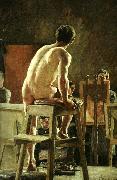 |
emil osterman
|
|
male model and pupils. ca. 1892
royal academy of fine arts
|
|
 |
Emil Orlik
|
|
(July 21, 1870 - September 28, 1932) was born in Prague, which was at that time part of the Austro-Hungarian Empire, and lived and worked in Prague, Austria and Germany. He was a painter, an etcher and lithographer.
In 1905 Emil Orlik moved to Berlin and took a post at the "School for Graphic and Book Art" of the Museum of Decorative Arts (Kunstgewerbemuseum), now part of the Berlin State Museums.
|
|
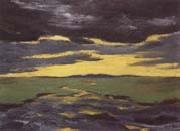 |
Emil Nolde
|
|
German Expressionist Painter, 1867-1956.German painter, watercolourist and printmaker. He was one of the strongest and most independent of the German Expressionists. Nolde belonged to the Dresden-based group known as DIE BR?CKE from 1906 to 1907. Primarily a colourist, he is best known for his paintings in oil, his watercolours and his graphic work. His art was deeply influenced by the stark natural beauty of his north German homeland, and alongside numerous landscapes, seascapes and flower paintings, Nolde also produced works with religious and imaginary subjects.
|
|
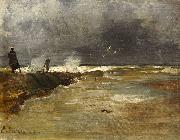 |
Emil Neumann
|
|
painted Strandspaziergang bei Wellengang in 1890
|
|
 |
Emil Lindgren
|
|
painted Interior med musicerande kvinnor vid pianot in 1893
|
|
|
|
 |
Emil Carlsen
|
|
Danish-born American Painter, 1853-1932
Soren Emil Carlsen (1853 ?C 1932) was an American painter associated with the Cos Cob Art Colony.
Carlsen painted primarily landscapes and still lifes. His fastidiously painted still lifes are influenced by Chardin and often depict copper pans, game, or flowers. He was an art teacher for over fifty years; his students included James Swinnerton.
|
|
|
|
Emil Barentzen
|
|
Emilius Ditlev Bærentzen, usually known as Emil Barentzen, (30 October 1799, Copenhagen - 14 February 1868, Copenhagen) was a Danish portrait painter and lithographer, active during the Golden Age of Danish Painting.
Born in Copenhagen on 30 October 1799, Barentzen served an apprenticeship at the pharmacy in Nykobing Sjælland but then travelled to Christiansted on the then Danish island of St. Croix in the West Indies where he worked in one of the government offices. Five years later he returned to Denmark and, after qualifying as a lawyer, moved into painting which until then he had practiced as a hobby. In 1821, he entered the Danish Academy where he studied under Christoffer Wilhelm Eckersberg. He was awarded the little silver medal in 1826 and the large silver medal the following year. He soon became one of Copenhagen's most popular portrait painters. His paintings were characterized by an elegant but sober style, free of psychological trimmings in accordance with contemporary practice. One of his most successful works is the portrait of Soren Kirkegaard's fiancee Regine Olsen (1840).
In 1837, he began to specialize in lithography with H.L. Danschell who managed his deceased father-in-law's oilcloth factory where stones were used to colour the fabric. This led to the founding of a lithographic company, Emilius Bärentzen & Co.s litografiske Institut, which later became Hoffensberg, Jespersen & Fr. Trap. Bærentzen made lithographs of many of the period's most important figures. He continued to work both as a lithographer and artist until 1866 when he painted the portraint of Cosmus Bræstrup for the Freemasons lodge in Helsingor. He died on 14 February 1868.
|
|
|
|
|
|
 |
Emanuel Leutze
|
|
historical painter, born in Gmund, Wurtemberg, 24 May, 1816; died in Washington, DC 18 July, 1868.American painter of German birth. When he was nine, Leutze's family emigrated to America and settled in Philadelphia. In 1834 he began to study art with the draughtsman John Rubens Smith (1775-1849). Leutze developed his skills as a portrait painter by taking likenesses to be engraved for publication in the National Portrait Gallery of Distinguished Americans and then working as an itinerant painter. He also experimented with imaginative compositions, such as the Poet's Dream (Philadelphia, PA Acad. F.A.). Philadelphia patrons sponsored his study in Europe, and in 1841 he enrolled at the Kenigliche Kunstakademie in Desseldorf. Although attempts at history painting won approval in Germany and in the USA, Leutze left the academy in 1843. He travelled for two years in Germany and Italy, during which time he became convinced of the importance of freedom and democracy,
|
|
 |
Emanuel Gottlieb Leutze
|
|
German-born American Romantic Painter, 1816-1868,American painter of German birth. When he was nine, Leutze's family emigrated to America and settled in Philadelphia. In 1834 he began to study art with the draughtsman John Rubens Smith (1775-1849). Leutze developed his skills as a portrait painter by taking likenesses to be engraved for publication in the National Portrait Gallery of Distinguished Americans and then working as an itinerant painter. He also experimented with imaginative compositions, such as the Poet's Dream (Philadelphia, PA Acad. F.A.). Philadelphia patrons sponsored his study in Europe, and in 1841 he enrolled at the K?nigliche Kunstakademie in Desseldorf. Although attempts at history painting won approval in Germany and in the USA, Leutze left the academy in 1843. He travelled for two years in Germany and Italy, during which time he became convinced of the importance of freedom and democracy, which he believed to be fundamental institutions of the American political system.
|
|
 |
Emanuel de Witte
|
|
(1617 - 1692) was a Dutch perspective painter. In contrast to Pieter Jansz Saenredam, who emphasized architectural accuracy, De Witte was more concerned with the atmosphere of his interiors. Though few in number, de Witte also produced genre paintings.
De Witte was born in Alkmaar and learned geometry from his father, a schoolmaster. He joined the local Guild of St Luke in 1636. After a stay in Rotterdam, he moved to Delft and studied with Evert van Aelst. In 1651 de Witte settled in Amsterdam where his first wife, Geerje Arents, died in 1655. He then married a 23-year-old orphan, Lysbeth van der Plas, who exercised a bad influence on de Witte's adolescent daughter. In December 1659 both were arrested for theft from a neighbor.Lysbeth, pregnant, had to leave the city for a period of six years; she lived outside the city walls and died in 1663.
Following the arrest of his wife and child, de Witte was forced to indenture himself to the Amsterdam notary and art dealer Joris de Wijs, surrendering all of his work in exchange for room, board, and 800 guilders annually. De Witte broke the contract, was sued by the dealer, and forced to indenture himself further as a result. Several patrons provided de Witte with support, but these relations did not work out well, for he tended to shout at his clients and at people watching him at work in churches. Records tell of his gambling habit and a fight with Gerard de Lairesse. According to Arnold Houbraken, after an argument about the rent, de Witte hanged himself from a canal bridge in 1692. The rope broke and de Witte drowned. Because the canal froze that night, his corpse was not found until eleven weeks later
|
|
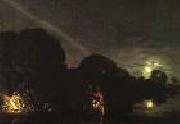 |
ELSHEIMER, Adam
|
|
German Baroque Era Painter, 1578-1610
German painter, printmaker and draughtsman, active in Italy. His small paintings on copper established him after his brief life as the most singular and influential German artist to follow D?rer. Their grand conception in terms of monumental figures and poetic landscape and their meticulous, miniature-like execution were admired by Rubens and came to influence many 17th-century artists, including Rembrandt. Most were produced in Rome after 1600:
|
|
|
|
|
|
|
|
|
|
|
| Wholesale China Oil Painting Wholesale Oil Painting China Xiamen Portrait Reproduction on canvas Chinese Oil Painting Wholesale USA Oil Painting |
|
|
|
|
|